Exploring the Intersection of Aging, Behavioral Health, and Care Quality
As the population ages, the intersection of geriatric behavioral health and long-term care quality is increasingly crucial. Behavioral health disorders among older adults, including mental illness and substance use disorders, significantly influence the quality ratings of healthcare facilities. This article examines how these challenges impact overall facility ratings and quality metrics, highlighting disparities in care access and the importance of enhancing measurement and treatment approaches to improve outcomes for the elderly.
Prevalence of Mental Illness and Substance Use Disorders Among Older Adults
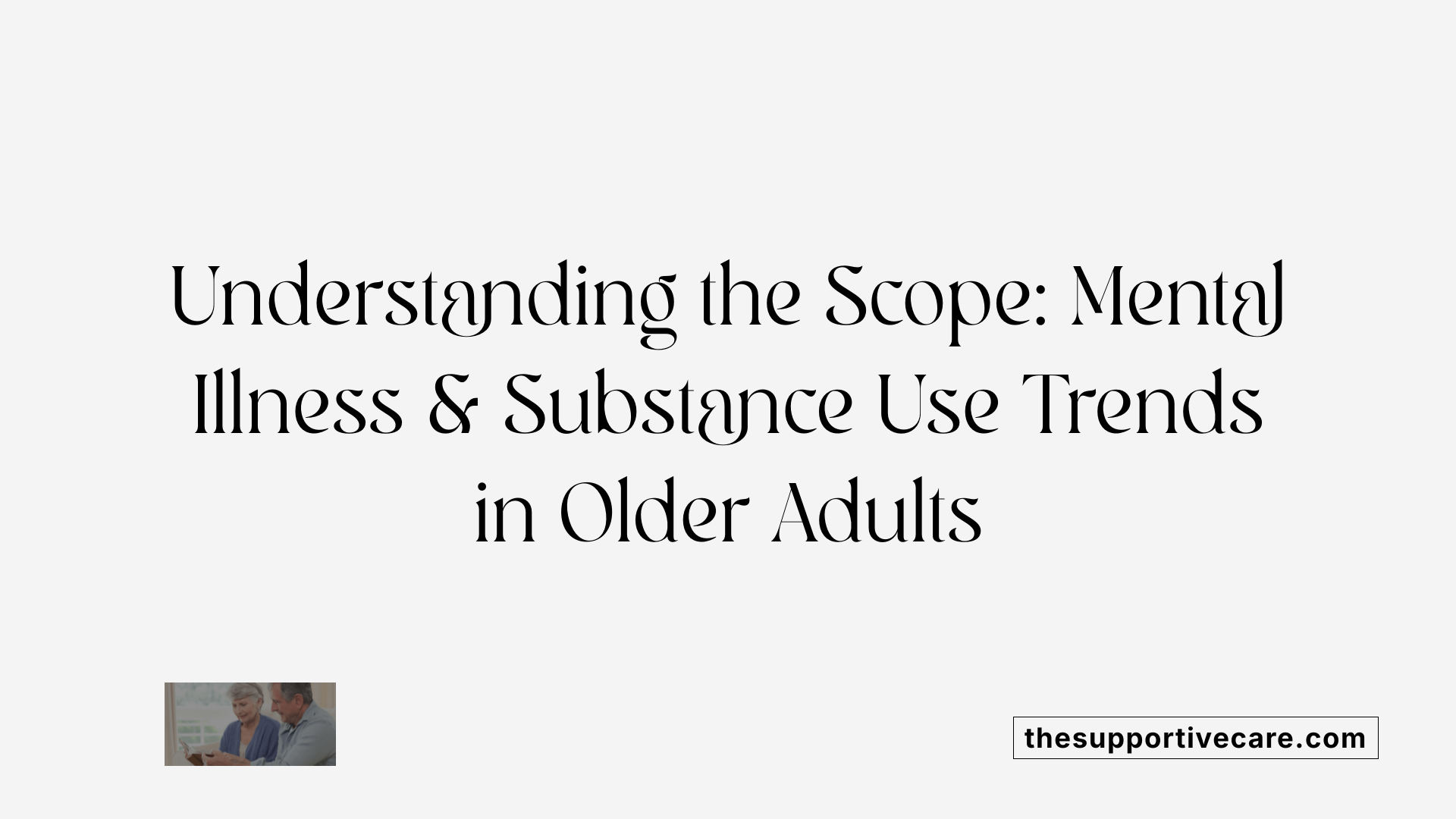
What is the prevalence of mental illness among older adults in the U.S.?
Approximately 1 in 8 older adults in the United States, about 12.5%, experienced some form of mental illness during 2021-2022. Among these, around 1.9% had serious mental illness, highlighting a substantial need for mental health support in this population.
Are there significant gender differences in mental health issues among older adults?
Significant gender differences exist in the prevalence of mental health conditions among older adults. Females report higher rates of mental illness, with 14.8% experiencing any mental illness compared to 9.8% of males. This pattern is particularly evident in major depressive episodes, where females are nearly twice as likely to suffer from depression as males.
What are the substance use trends among older adults?
Substance use remains an important public health concern for older adults. About 10% of older adults used illicit drugs in the past year, including 12.5% who used marijuana and 2.3% engaging in opioid misuse. Binge drinking is also notable, with 12.8% of older adults participating—this behavior is more common among males, with over 1 in 7 engaging in binge drinking compared to roughly 1 in 10 females. Additionally, around 9.1% of older adults had a substance use disorder, with males more affected than females.
These findings underscore the importance of targeted mental health and substance use interventions tailored to older adults, with attention to gender-specific patterns and needs.
Gender-Specific Behavioral Health Challenges in Older Adults
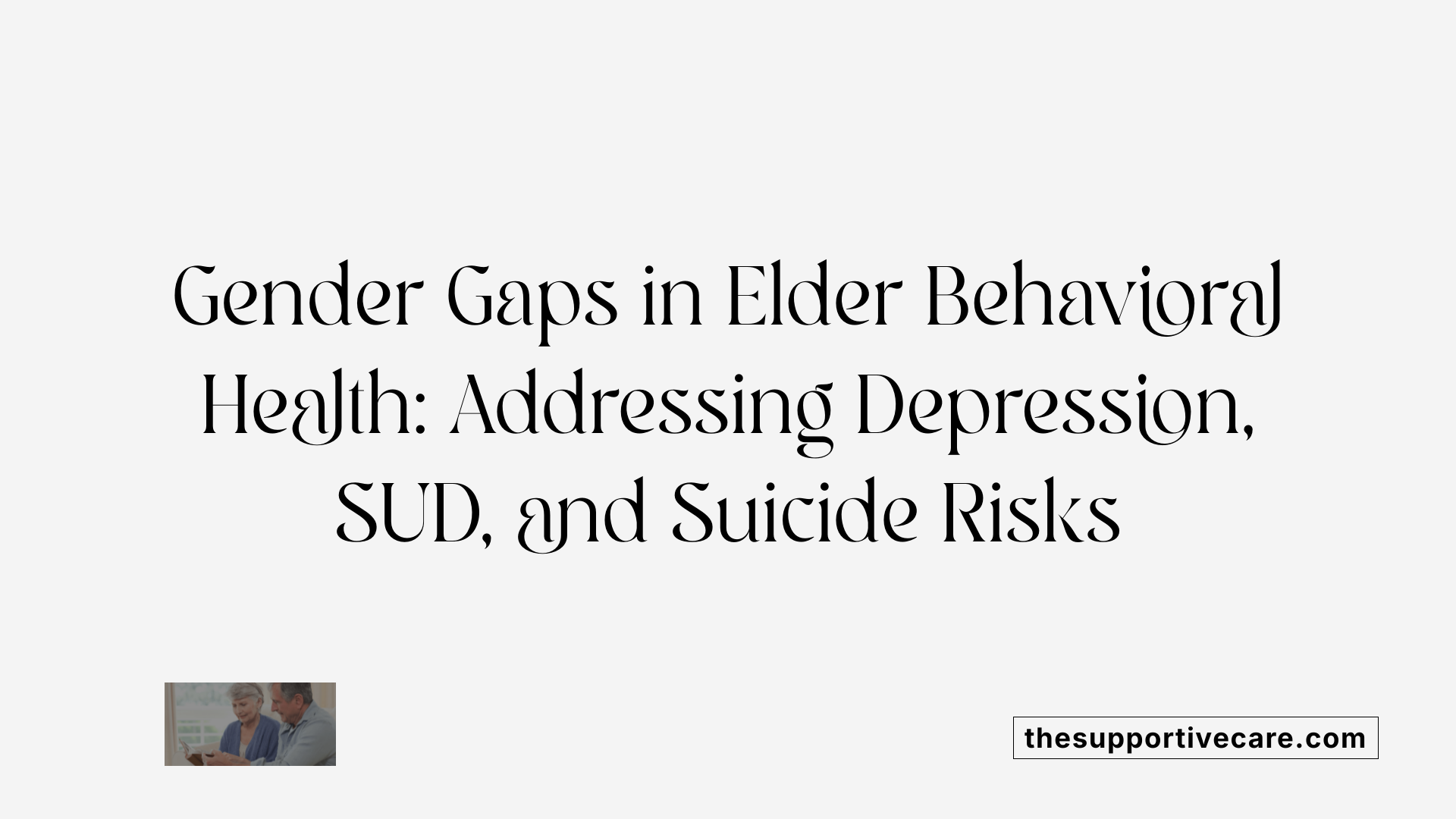
How do major depressive episodes differ by gender in the elderly?
Major depressive episodes (MDE) affect about 2.7 million older adults annually. Women are nearly twice as likely as men to experience an MDE, reflecting a significant gender disparity in depression rates among the elderly.
Are substance use disorders more common in older males or females?
Substance use disorders (SUDs) affect roughly 9.1% of older adults, with male seniors exhibiting a higher prevalence than females. Older men are also more prone to engage in binge drinking and illicit drug use compared to their female counterparts.
What is known about suicidal thoughts and death rates in older adults?
Serious suicidal thoughts occur in about 1 in 50 older adults, with similar rates observed in both genders. However, despite comparable ideation rates, older males have a notably higher suicide death rate, highlighting critical gender-specific risks.
Overall, these gender differences underscore the importance of tailored behavioral health interventions in older populations to address depression, substance misuse, and suicide risk effectively.
Current Gaps in Treatment Access for Older Adults with Behavioral Health Needs
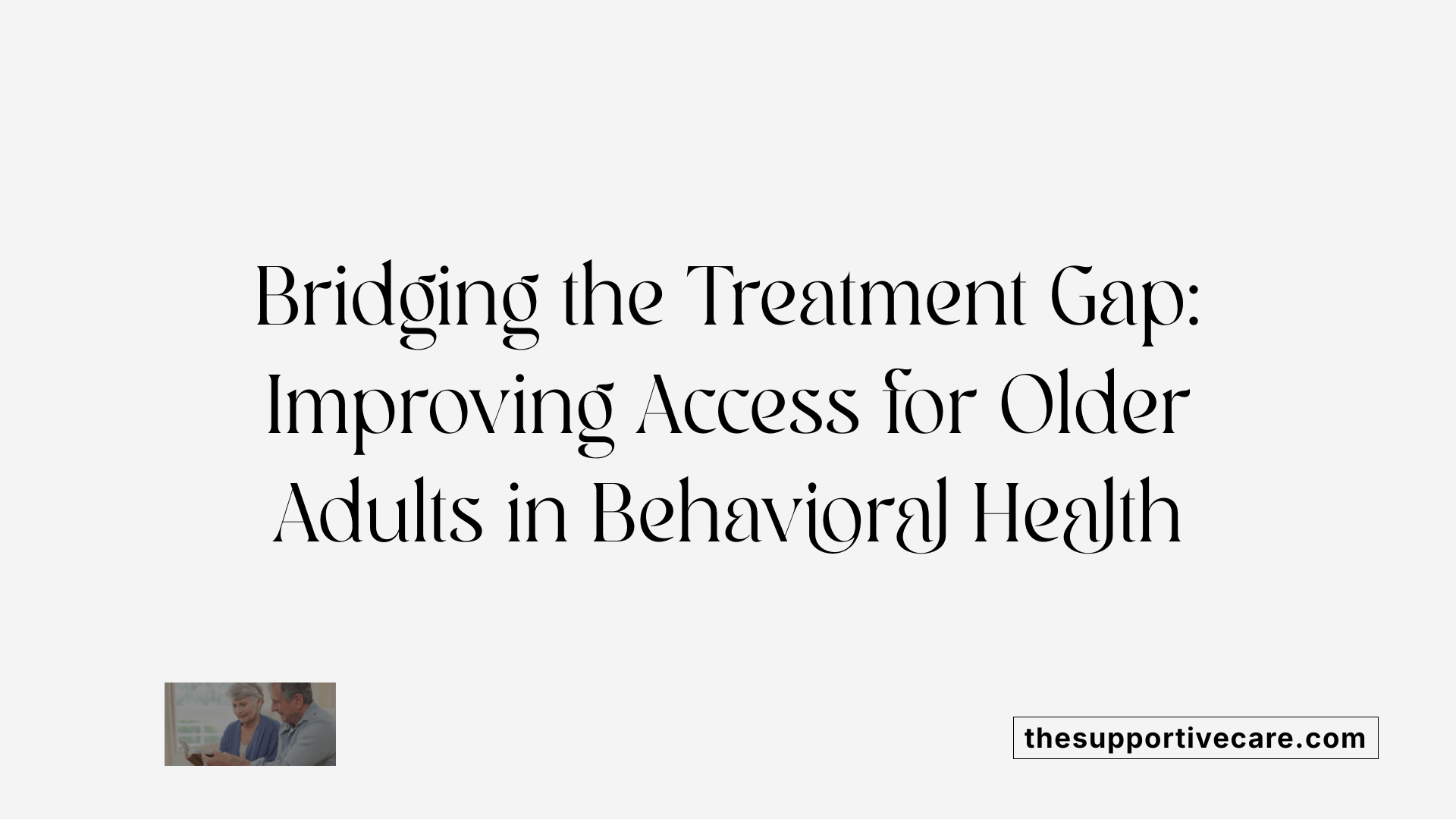
How many older adults in need of substance use treatment actually receive it?
Fewer than 30% of older adults who needed treatment for substance use disorders (SUD) received it in the past year. A significant barrier is the lack of perceived need for treatment among this population, with most older adults not recognizing their condition as requiring professional care. This perception gap contributes heavily to low treatment engagement.
What proportion of older adults received mental health treatment recently?
Approximately 16% of older adults received some form of mental health treatment during the past year. Women are slightly more likely to access these services than men. Despite this, the majority of older adults with mental health conditions remain untreated, underscoring ongoing challenges in care accessibility.
What are the perceptions about treatment need and additional barriers?
The low treatment rates are partly driven by insufficient awareness and stigma around mental health and substance use disorders in older populations. Many older adults do not perceive the need for treatment even when they experience significant symptoms. Other barriers include inadequate screening, limited availability of age-appropriate services, and challenges related to insurance coverage and coordination of care.
Overall, these treatment gaps highlight a critical need to enhance outreach, education, and service integration targeted at older adults. Addressing misconceptions and improving screening and referral processes could bridge access disparities and improve outcomes in this vulnerable group.
Impact of Behavioral Health Conditions on Nursing Home Quality Ratings
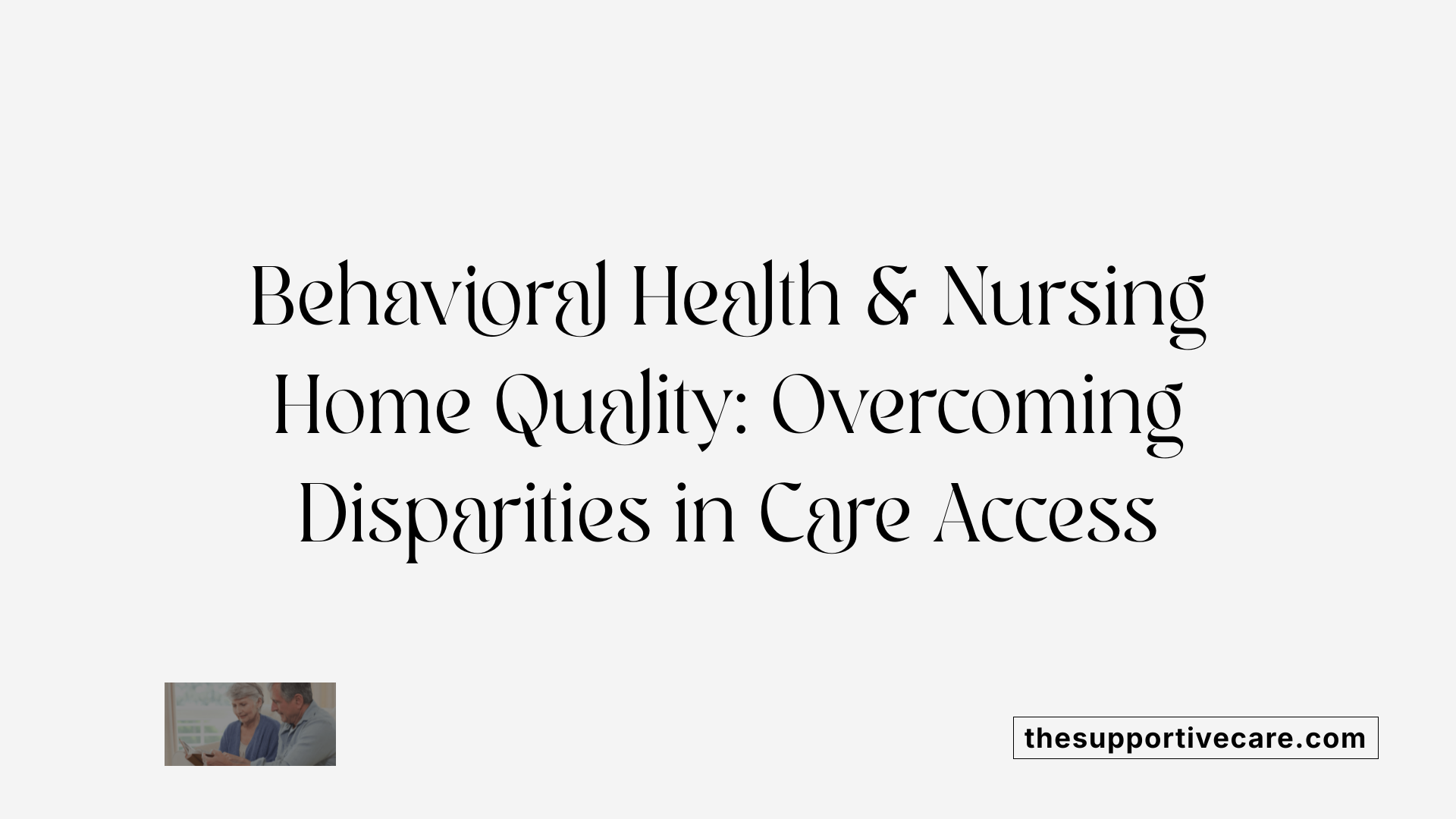
How does having a behavioral health disorder affect nursing home placement quality?
Patients with behavioral health disorders, including mental health and substance use conditions, tend to be admitted to nursing homes with lower quality ratings than those without such disorders. This trend reflects significant challenges in securing high-standard placements for these individuals.
Do disparities exist in access to higher-quality nursing homes for patients with behavioral health issues?
Yes, disparities in access to high-quality nursing homes for patients with behavioral health conditions persist over time. These gaps are not limited to patients with serious mental illnesses but also extend to a broad range of behavioral health disorders such as depression, anxiety, schizophrenia/psychosis, and bipolar disorder. For example, patients with depression and anxiety make up about one-third of new post-acute nursing home admissions but often have reduced access to five-star rated facilities, especially with regard to staffing quality.
What quality metrics are used to evaluate nursing homes in this context?
The Centers for Medicare and Medicaid Services (CMS) Five-Star Quality Rating System is the primary metric used to assess the quality of nursing homes. This system includes evaluations across several domains, including overall facility performance and staffing quality. Research controlling for patient characteristics shows that although these adjustments reduce disparities, patients with behavioral health disorders still face greater barriers to accessing higher-rated nursing homes.
| Aspect | Details | Example / Impact |
|---|---|---|
| Behavioral Health Impact | Lower likelihood of admission to high-quality nursing homes | Patients with mental health conditions often placed in lower-rated facilities |
| Disparities in Access | Persistent over time and across multiple behavioral health conditions | Lower access for patients with depression, anxiety, schizophrenia, bipolar disorder |
| Quality Measurement Tool | CMS Five-Star Quality Rating System | Includes overall and staffing domains to quantify nursing home quality |
These findings highlight ongoing barriers faced by individuals with behavioral health conditions in receiving equitable and high-quality nursing home care.
Specific Behavioral Health Diagnoses and Their Facility Placement Challenges
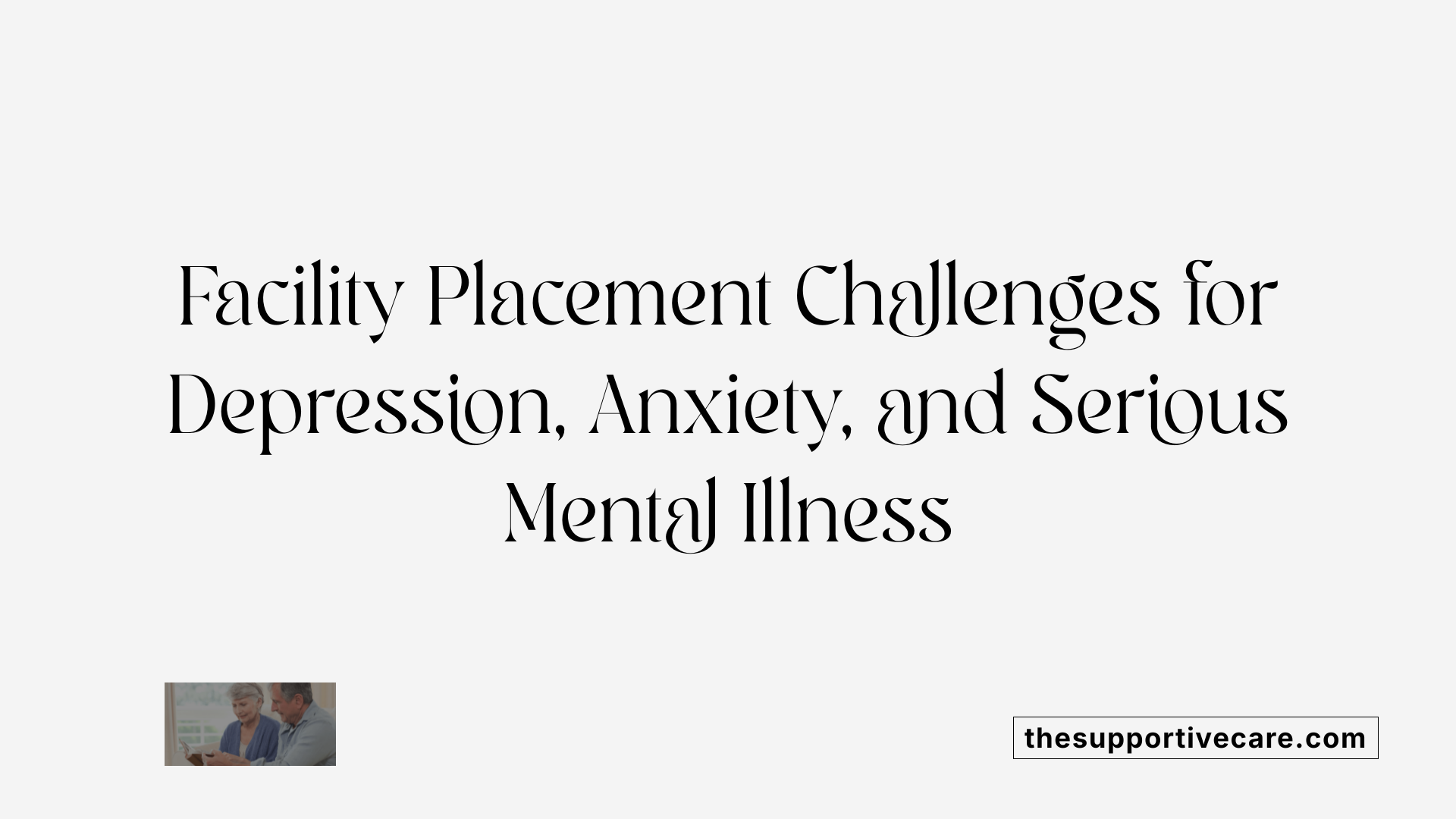
How do depression and anxiety affect nursing home placement for older adults?
Patients with depression and anxiety represent a significant portion of new post-acute admissions to nursing homes—about one-third of all new cases. Despite this prevalence, they often face difficulties accessing top-rated facilities. Specifically, these patients have lower admission rates to nursing homes rated five stars, especially when considering staffing quality. This suggests that even commonly diagnosed behavioral health conditions can significantly impact the quality of care environments available to older adults.
What challenges do patients with schizophrenia or bipolar disorder face in facility placement?
Similar to those with depression and anxiety, patients diagnosed with schizophrenia, psychosis, or bipolar disorder encounter barriers when seeking placement in high-quality nursing homes. These obstacles reflect broader disparities within the behavioral health spectrum, limiting their access to facilities with superior care standards. Although adjustments for patient characteristics reduce these disparities, they do not fully eliminate them, indicating systemic challenges in care placement based on behavioral health diagnoses.
Overview of Behavioral Health Placement Barriers
| Diagnosis Category | Impact on Nursing Home Placement | Specific Barriers Identified |
|---|---|---|
| Depression and Anxiety | Accounts for 1/3 of new admissions; lower access to 5-star rated homes | Staffing quality deficits |
| Schizophrenia & Bipolar Disorder | Similar barriers to access as other behavioral health groups | Systemic placement disparities despite adjustments |
This data underscores the need for targeted policy and care improvements to enhance access and equity in nursing home placements for older adults with behavioral health disorders.
Quality Measurement Challenges in Behavioral Health Care for Older Adults
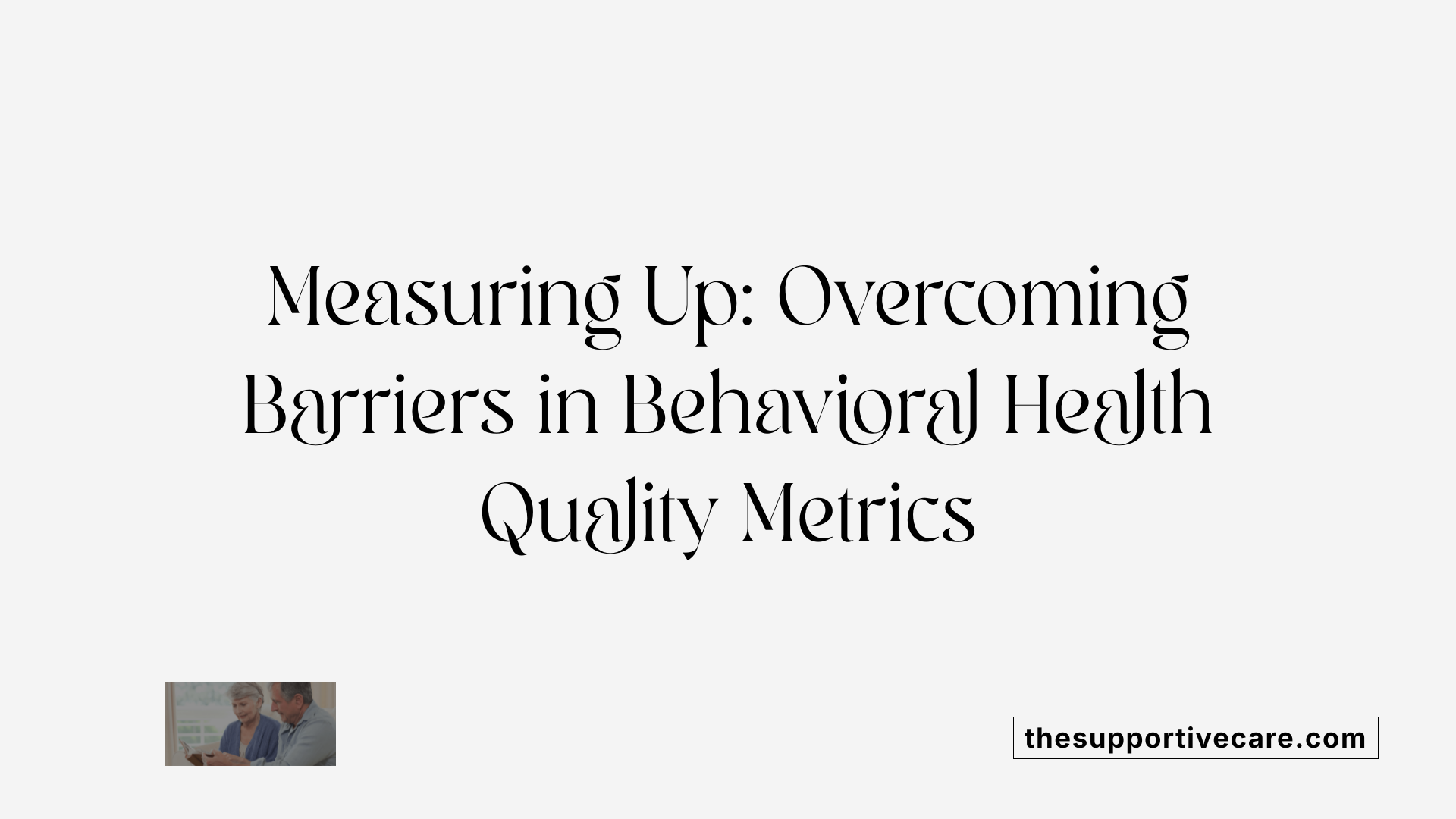
What are the barriers to quality measurement in behavioral health?
Measuring quality in behavioral health care for older adults faces several significant obstacles. One major challenge is the lack of standardized diagnostic methods, which makes consistent assessment and comparison difficult. Unlike many physical health conditions, behavioral disorders often rely on subjective evaluations, leading to variability in diagnosis and treatment documentation.
There are also evidence gaps in quality measures. Many proposed quality indicators suffer from limited scientific backing or insufficient validation, leaving policymakers and providers without comprehensive tools to reliably gauge the effectiveness or safety of care practices. For example, while depression screening has well-established measures, areas like treatment intensification or continuity of care lack clear benchmarks.
Additionally, leadership and policy shortcomings hamper progress. The behavioral health field has historically seen fragmented oversight and limited initiatives focused on improving measurement frameworks. This results in inconsistent adoption of quality metrics across facilities and less emphasis on integrating measurement into everyday clinical practice.
Addressing these barriers requires coordinated efforts to develop standardized assessment tools, strengthen evidence for quality indicators, and promote leadership to guide quality improvement initiatives. This is crucial for older adults, who face unique behavioral health challenges and disparities in care quality.
| Barrier | Description | Impact on Older Adults' Care |
|---|---|---|
| Lack of standardized methods | Variability in diagnosing and documenting mental health conditions | Inconsistent treatment, difficult quality comparisons |
| Evidence gaps | Limited scientific validation for many quality measures | Uncertainty in best practices, incomplete monitoring |
| Leadership barriers | Fragmented governance and limited strategic focus on quality improvement in behavioral health | Slow adoption of improvements, fragmented care standards |
Proposed Quality Indicators for Mental Health and Substance Use Disorder Care
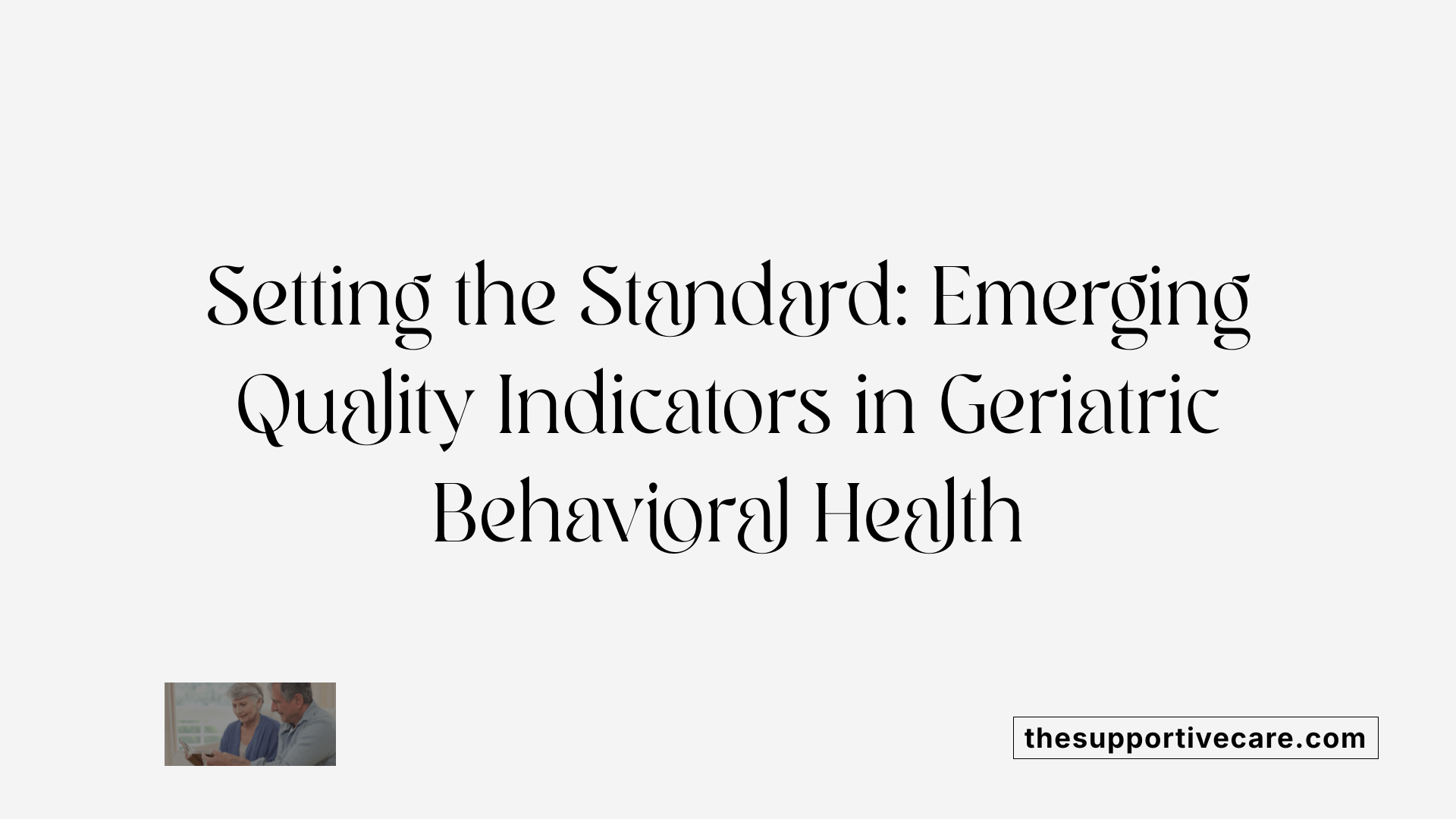
What quality indicators have been proposed for behavioral health care?
To enhance the quality of mental health and substance use disorder (SUD) care, experts have proposed a comprehensive set of ten quality indicators. These indicators are designed to address multiple dimensions of healthcare quality, ensuring a more well-rounded and patient-focused approach. The framework covers six domains: safety, effectiveness, patient-centeredness, timeliness, efficiency, and equity. This multi-domain strategy aims to systematically improve behavioral health services and address existing gaps in care quality.
What are some example measures used in this framework?
Several specific measures illustrate how these quality indicators can be applied in practice. For instance, monitoring the metabolic side effects of antipsychotic medications helps ensure patient safety, given the potential risks linked to these drugs. Screening for depression and tracking remission rates focus on effectiveness and timeliness, facilitating early intervention and ongoing treatment success. Additionally, screening for alcohol abuse exemplifies patient-centeredness and preventative care. Finally, reducing rehospitalization rates works toward improving efficiency and equity by supporting sustained recovery and reducing disparities in care outcomes.
These indicators not only provide benchmarks for healthcare providers but also highlight opportunities for systemic improvements. By addressing both clinical outcomes and patient experiences, the framework supports better integration of behavioral health into broader healthcare quality initiatives. Ultimately, such measures are crucial for advancing mental health and substance use treatment, improving outcomes, and decreasing disparities among older adults and the general population.
Integration of Behavioral Health Care into Health IT Systems
How can health information technology improve behavioral health care quality?
The integration of behavioral health care into health information technology (IT) systems plays a crucial role in enhancing care quality for older adults. By embedding mental health and substance use disorder assessments into electronic health records, providers can consistently apply standardized tools like the Patient Health Questionnaire-9 (PHQ-9) to screen for depression.
This digital approach streamlines the collection of accurate patient data, enabling timely identification of mental health issues. It also supports continuous monitoring of patient progress and treatment responses, contributing to more personalized and effective care.
Use of standardized assessment tools like PHQ-9
Standardized tools such as the PHQ-9 provide a validated method for evaluating depression severity and treatment outcomes. When incorporated into health IT systems, these assessments can be automatically administered and tracked over time.
This integration reduces variability in diagnosis and helps clinicians detect changes in mental health earlier. It also facilitates communication among care teams by ensuring consistent data availability, which is especially important for coordinating care in older adults with complex health needs.
Developing benchmarks for performance accountability
Embedding behavioral health metrics into health IT allows health systems and providers to establish performance benchmarks. These benchmarks, based on consistent data collection, support accountability efforts by highlighting areas needing improvement, such as screening rates or treatment adherence.
Moreover, health IT enables the aggregation of data across populations to identify disparities in care quality, guiding targeted interventions to promote equity. This systematic approach is key to aligning behavioral health care quality with broader healthcare improvement initiatives and reducing the burden of mental health and substance use disorders among older adults.
The National Behavioral Health Quality Framework and Measure Landscape
How extensive is the set of behavioral health quality measures?
There are currently 510 behavioral health quality measures identified under the National Behavioral Health Quality Framework (NBHQF). These measures cover a broad range of priorities within behavioral health care. A large majority—72%—are process measures, which focus on how healthcare services are delivered. Moreover, 89% depend primarily on administrative claims data, underscoring the reliance on existing billing and service records for evaluating care quality.
How many measures have been nationally endorsed?
Out of the 510 measures, only a small fraction—about 10%, or 53 measures—have received endorsement from the National Quality Forum (NQF). This indicates that most of the measures have yet to undergo rigorous validation and formal acceptance by key national quality organizations.
What are the main focus areas in behavioral health quality measurement?
Most existing measures emphasize screening and assessment processes, medication adherence, psychosocial interventions, and safety within behavioral health care. Measures related to substance use issues include screening for depression among patients with substance dependence, counseling for alcohol dependence, and screening for unhealthy alcohol use. However, there are notable gaps, including few endorsed measures addressing treatment intensification, financial barriers to care, and continuity of care.
How is administrative data utilized in these measures?
Administrative claims data serves as the foundation for most measures, facilitating large-scale assessments of care patterns, compliance, and outcomes. This reliance helps with standardizing measurement but also limits the scope to information available through billing and records rather than clinical details.
This landscape highlights both the progress made and the challenges remaining in measuring the quality of behavioral health services, pointing toward future needs for more comprehensive, validated, and outcome-focused indicators.
Limitations and Opportunities in Current Behavioral Health Quality Measures

What are the limitations of current behavioral health quality measures?
Behavioral health quality measurement faces several notable challenges. Despite identifying over 500 quality measures, only about 5% are incorporated into public reporting programs. This limited public visibility hampers accountability and improvement efforts. Moreover, a large majority of existing measures focus primarily on processes such as screening, assessment, and medication adherence, relying heavily on administrative claims data.
Significant gaps persist in measurement domains. Few endorsed measures exist for critical areas like treatment intensification, which involves adjusting therapies for better outcomes. Financial barriers to care—which affect access and adherence—are also underrepresented. Additionally, continuity of care measures, essential for assessing the seamlessness of patient experience across settings, remain sparse.
What opportunities exist for future measure development?
There are promising prospects for expanding the behavioral health measurement landscape. New measures could capture combined pharmacotherapy and psychosocial treatments, reflecting more comprehensive care approaches. Family involvement metrics might help evaluate the role of caregivers and support systems in treatment success.
Further development is needed for measures addressing safety concerns, such as medication errors and injury rates within behavioral health settings. Enhancing measurement in these areas would contribute to patient safety and improved outcomes. By broadening measure domains and increasing public reporting usage, stakeholders can drive quality care improvements and reduce disparities in behavioral health treatment.
Substance Use Treatment Facilities: Characteristics and Access Considerations

How many substance use treatment facilities exist and what services do they offer?
There are approximately 14,700 facilities in the U.S. dedicated to providing substance use treatment. A significant majority—over 80%—focus on outpatient services, making treatments accessible without requiring extended stays. In contrast, inpatient and residential care options make up smaller portions of available services, catering to patients with more intensive treatment needs.
What ownership models exist for substance use treatment facilities?
Ownership of these facilities varies, with most classified as non-profit organizations. However, for-profit ownership is notably more prevalent in substance use treatment than in mental health services, accounting for about 43% of facilities in this category. Additionally, public or government ownership represents around 9%, contributing a modest share to the overall landscape.
How do insurance participation rates affect access?
The ability of patients to access these facilities is influenced heavily by insurance participation. Most substance use treatment centers accept private insurance and Medicaid. However, Medicaid participation rates show significant variation across states, which can limit treatment accessibility for low-income populations in certain regions. Participation levels in Medicare, Tricare, and Indian Health Services are generally lower, suggesting potential gaps in coverage for some older adults and specific groups.
| Aspect | Details | Implications |
|---|---|---|
| Number of Facilities | ~14,700 substance use treatment facilities | Large network primarily outpatient-based |
| Service Types | Over 80% outpatient, smaller inpatient/residential | Accessibility varies with intensity of care |
| Ownership | Majority non-profit; 43% for-profit; 9% public | Diverse ownership influences operational focus |
| Insurance Participation | High for private insurance and Medicaid; variable by state | Medicaid variability affects low-income access |
Understanding these facility characteristics and ownership patterns is crucial in addressing how substance use treatment is accessed and delivered across the United States.
Mental Health Treatment Facilities and Their Role in Geriatric Care
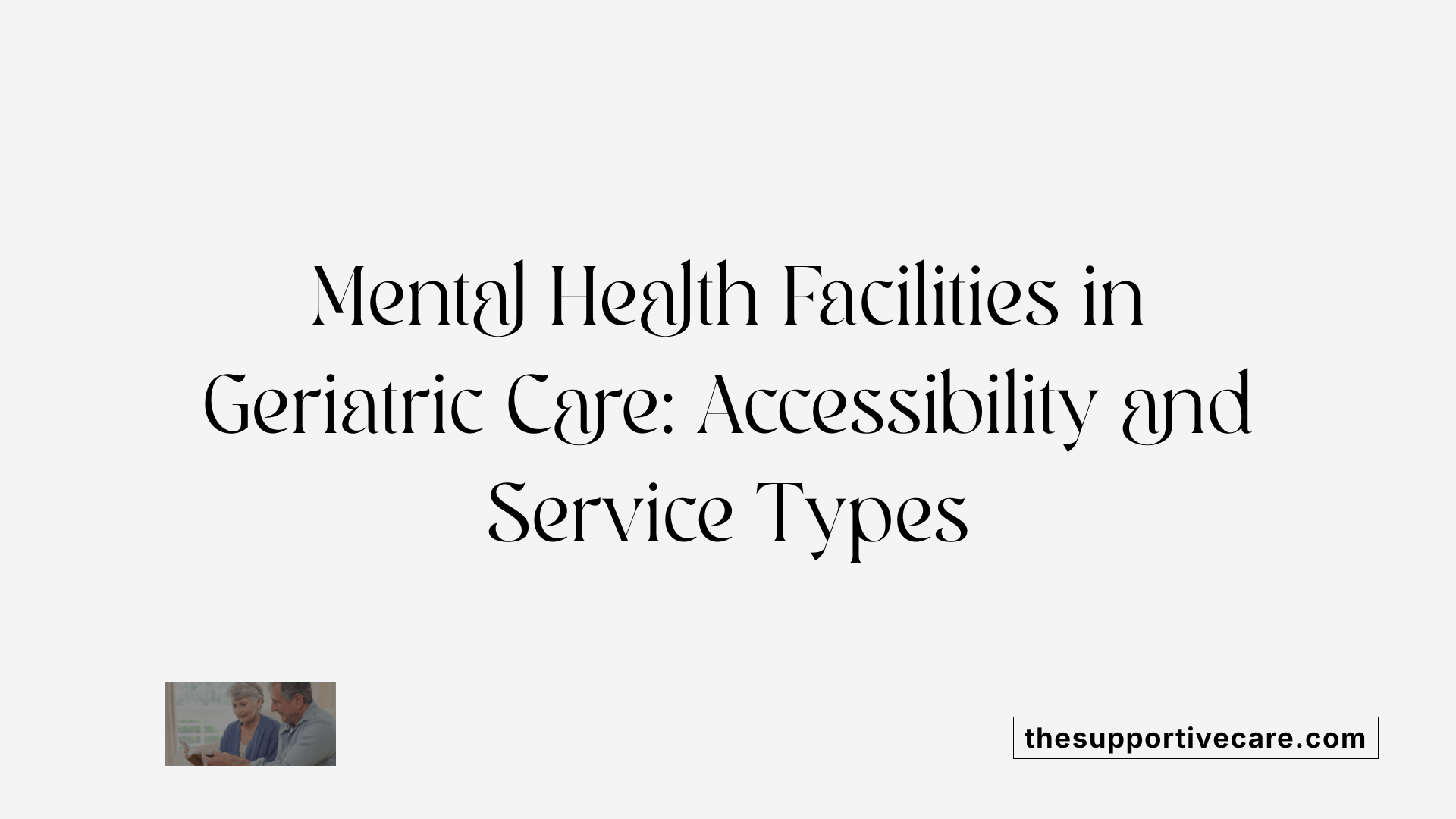
What is the availability of mental health treatment facilities for older adults?
Across the United States, approximately 9,500 facilities offer mental health services. These facilities primarily provide outpatient care, which accounts for over 80% of the services available. This widespread availability supports older adults in managing mental health conditions close to their communities.
How do ownership and insurance participation compare to substance use treatment facilities?
Mental health treatment facilities differ notably in ownership structure from substance use treatment centers. Only about 19% of mental health facilities are for-profit, while nearly double that rate, 43%, characterizes substance use treatment centers. Moreover, public or government ownership represents approximately 18% of mental health facilities but only 9% of substance use facilities.
Insurance participation is a critical factor affecting access to care. Most mental health facilities report high participation with private insurance and Medicaid, which is especially important for older adults with limited income. However, participation rates for Medicare, Tricare, and Indian Health Service are comparatively lower. Medicaid participation varies widely across states, sometimes dipping below 70%, impacting accessibility for low-income older adults relying on Medicaid.
Service Types and Focus
Both mental health and substance use treatment facilities mainly provide outpatient services, with fewer offering inpatient or residential care. This emphasis on outpatient treatment aligns well with older adults’ need for consistent, accessible, and less disruptive care options.
The combination of facility availability, ownership models, and insurance participation influences the quality and accessibility of mental health care for older adults. Understanding these dynamics is essential for addressing gaps in care and supporting this vulnerable population effectively.
Addressing Disparities in Geriatric Behavioral Health Care
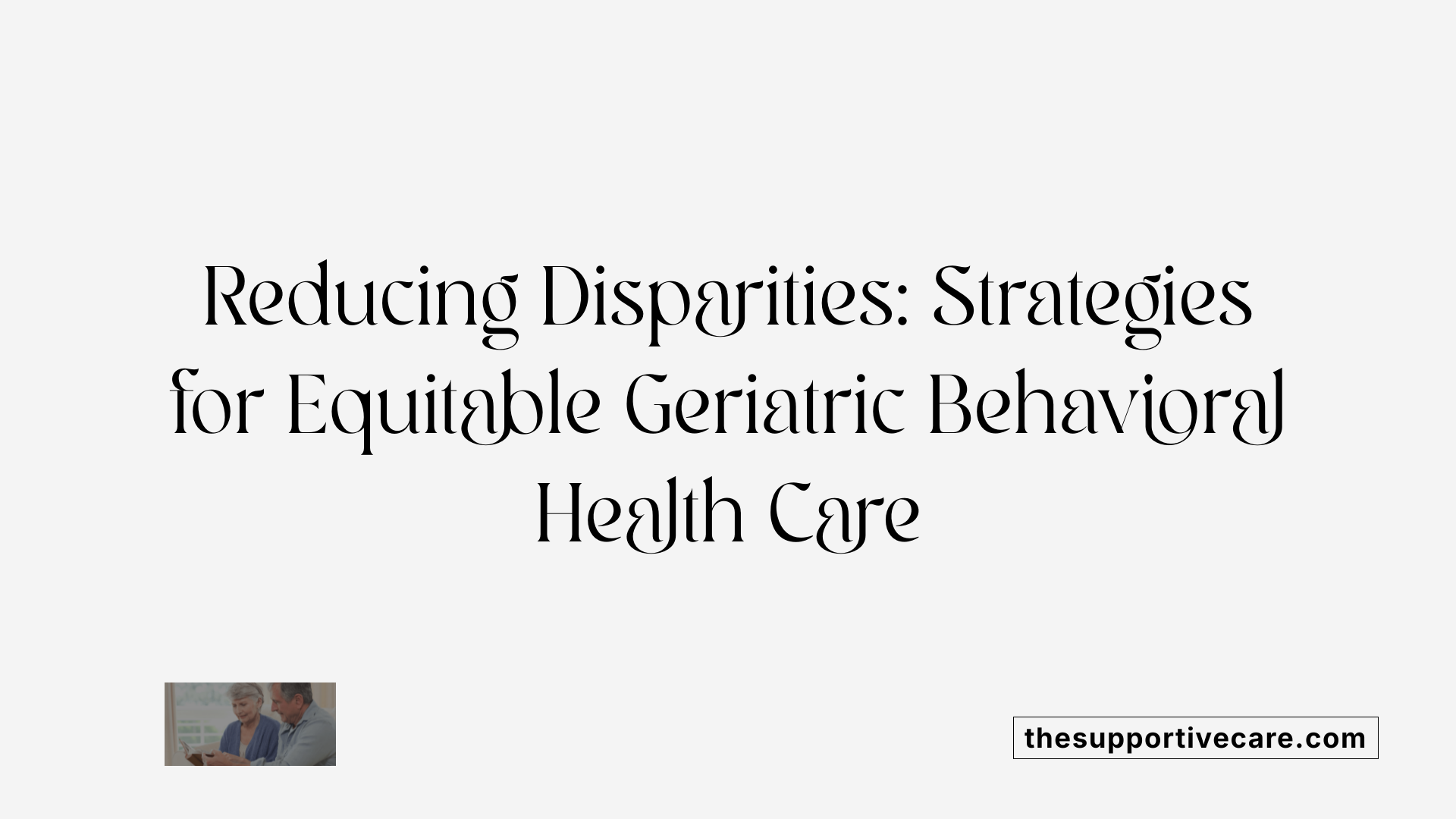
What disparities exist in geriatric behavioral health care?
Older adults with behavioral health disorders—ranging from depression and anxiety to serious mental illnesses—face considerable disparities in access to high-quality care. Research shows that these patients are often admitted to nursing homes with lower overall quality ratings, especially in staffing, compared to older adults without behavioral health conditions. For example, nearly one-third of new post-acute nursing home admissions are patients with depression or anxiety, yet these individuals have diminished access to five-star facilities.
Disparities extend beyond nursing homes to include mental health and substance use treatment facilities. While many centers offer outpatient services, the availability of inpatient and residential care beds varies widely by state. Ownership models also differ; substance use treatment facilities are more frequently for-profit than mental health facilities, which may influence care quality and accessibility. Additionally, Medicaid participation varies across states, impacting treatment accessibility for low-income older adults.
How can improving quality measurement reduce these disparities?
Quality measurement plays a pivotal role in reducing disparities and enhancing geriatric behavioral health care. Currently, only a fraction of behavioral health quality measures are nationally endorsed or publicly reported. Expanding the use of standardized measurement tools—such as depression screening instruments like PHQ-9—and integrating mental health data into health IT systems can promote accountability and facilitate timely, effective care.
A set of proposed quality indicators targets comprehensive dimensions including safety, effectiveness, patient-centeredness, timeliness, efficiency, and equity. Measures focusing on medication side effects, depression remission, alcohol abuse screening, and rehospitalization rates exemplify the kind of targeted improvements that can close gaps.
Furthermore, aligning behavioral health initiatives with broader healthcare quality frameworks encourages resource allocation and leadership commitment to these historically underserved areas. This alignment supports reducing access barriers and enhances outcomes by fostering coordinated, culturally competent care tailored to the unique needs of older adults.
| Aspect | Challenges in Geriatric Behavioral Health | Quality Improvement Approaches |
|---|---|---|
| Access to High-Quality Care | Lower facility ratings, Medicaid variability | Public reporting, facility benchmarking |
| Measurement Availability | Limited endorsed measures, predominance of process metrics | Development of outcome measures, broader data use |
| Integration with Broader Care | Fragmented systems, low IT adoption | Health IT integration, standardized assessment tools |
| Treatment Types | Limited inpatient/residential beds, diverse ownership | Expanded service capacity, attention to ownership impact |
Addressing these disparities through enhanced measurement, standardization, and integration is critical to advancing geriatric behavioral health care quality and equity.
The Societal and Economic Implications of Geriatric Behavioral Health Challenges
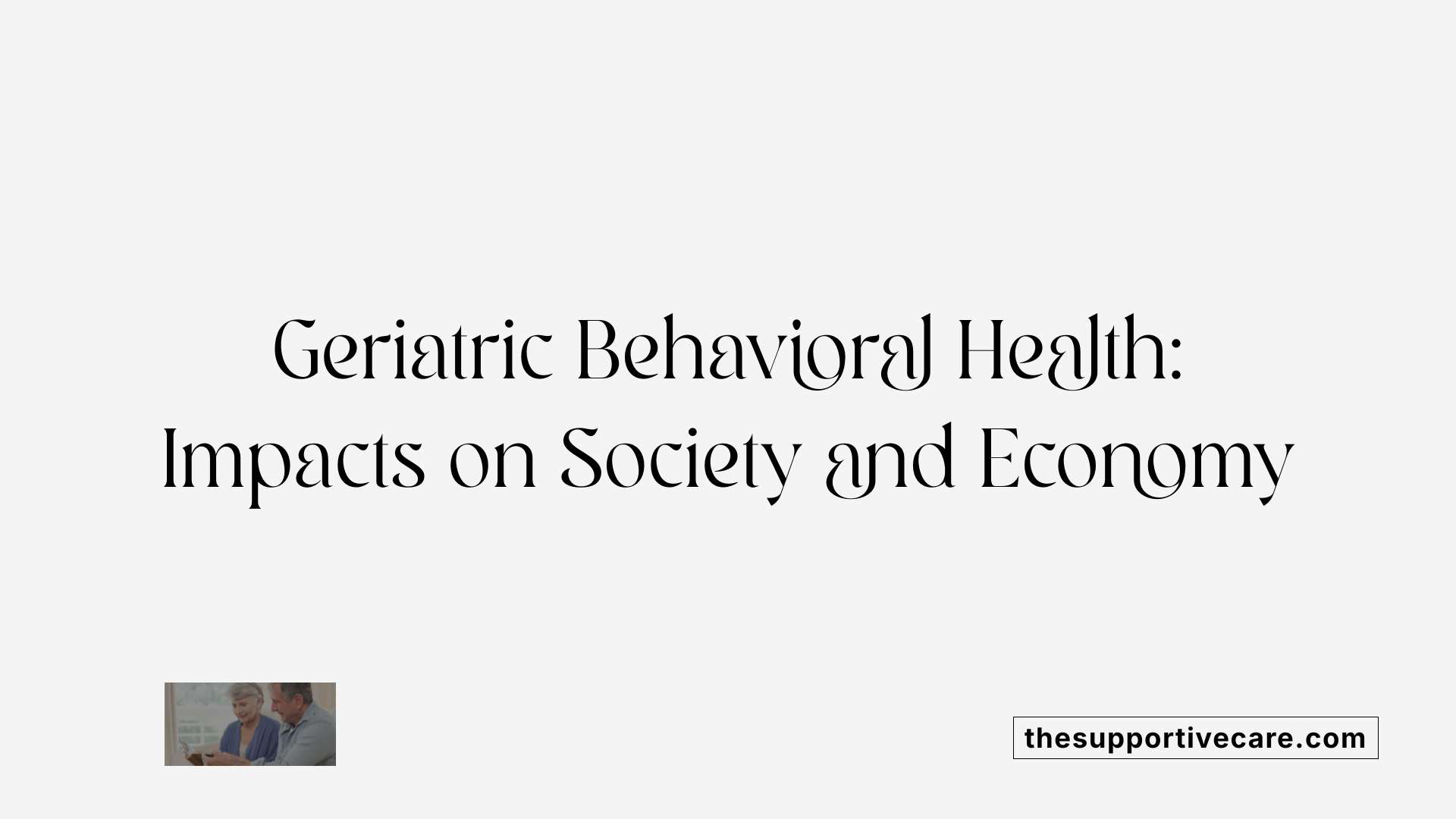
Prevalence and Cost Burdens of Mental Illness and Substance Use
Mental health and substance use disorders are common among older adults, with around 12.5% experiencing mental illness and approximately 9.1% having substance use disorders annually. These conditions not only affect individual well-being but also entail substantial costs. The high prevalence contributes to increased healthcare utilization, disability, and lost productivity, imposing significant economic strain on families and society at large.
Impact on Healthcare Systems and Society
Mental illness and substance use disorders among older adults lead to greater demands on healthcare resources, including specialized treatment facilities, nursing homes, and hospitalization. These conditions are linked to poorer access to high-quality nursing homes and increased rehospitalization rates, highlighting systemic challenges. Moreover, societal burdens extend beyond healthcare costs to include increased caregiver strain and reduced quality of life within communities.
Importance of Quality Improvement
Improving the quality of behavioral health care is crucial not only for affected individuals but also for reducing societal and economic burdens. Despite high prevalence, mental health and substance use treatment quality has lagged behind other healthcare sectors. Implementing quality indicators focused on safety, effectiveness, timeliness, and equity can enhance patient outcomes and reduce costly complications. Enhanced quality measurement and improvement efforts are essential to align behavioral health care with overall health care quality initiatives and ensure equitable access for older adults.
Why is improving geriatric behavioral health care important beyond individual patients?
Mental health and substance use disorders impose high societal and economic costs, stressing healthcare systems; quality improvement is essential to manage these burdens.
Conclusion: Moving Toward Enhanced Quality and Equity in Geriatric Behavioral Health Care

What is the overall impact of geriatric behavioral health on care facility ratings and quality?
Behavioral health issues among older adults heavily influence the quality and ratings of care facilities. Patients suffering from mental health disorders, such as depression, anxiety, schizophrenia, or bipolar disorder, are consistently found to have limited access to high-quality nursing homes, especially those with top-tier staffing. Even after adjusting for various patient characteristics, these disparities in access persist, highlighting systemic challenges within care allocation.
What are the recommended pathways for future improvements?
Enhancing care quality in geriatric behavioral health hinges on several strategic efforts. There's a pressing need to develop and implement comprehensive quality measures that go beyond the existing focus on process metrics, such as screening and medication adherence, to include treatment intensification and continuity of care. Integrating behavioral health services into broader health information systems and adopting standardized assessment tools can improve monitoring and accountability.
Expanding access is equally vital. Many older adults who require substance use treatment do not receive it, partly due to the lack of perceived need and facility availability. Strengthening Medicaid and insurance participation at treatment centers can alleviate barriers for low-income populations. Additionally, increasing public and private investment in substance use and mental health services, especially inpatient and residential care beds, would better meet growing demands.
Vision for future advancements
Looking ahead, the behavioral health field must pursue equity-driven quality improvements that are systematically embedded into all levels of geriatric care. This includes refining national quality indicator sets to encompass diverse patient needs, capturing patient-centered outcomes, and addressing social determinants of health. Enhanced interoperability of care data and leadership commitment will empower providers to deliver safer, more effective, and timely care.
Ultimately, aligning behavioral health quality efforts with overall healthcare quality agendas will reduce disparities, improve mental health outcomes, and foster a more inclusive system that respects and prioritizes older adults’ well-being.
Enhancing Care Quality for Older Adults with Behavioral Health Needs
The intersection of geriatric behavioral health and care quality metrics reveals complex challenges and critical opportunities. As behavioral health disorders remain prevalent among older adults, their influences permeate facility ratings and access to care. Addressing measurement gaps, reducing disparities, and bolstering treatment availability are imperative steps toward ensuring that older adults receive equitable, effective, and patient-centered care. By embracing comprehensive quality improvement efforts, healthcare systems can better meet the unique needs of the elderly population, ultimately enhancing outcomes and quality of life.



































































































